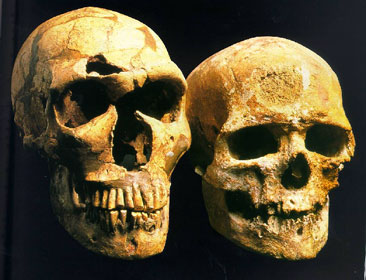
Anthropology 593 / Anthropology 486
Evolution and Social Life
Theme for Fall 2015: The origin and dispersal of modern humans.

Left: La Ferrassie Neanderthal, right: Cro-Magnon modern human
Course description
Is there a relationship between living people and Neanderthals? Did the late Pleistocene see the global replacement of one kind of human by another? Were Neanderthals able to interbreed with modern humans? Were they behaviourally clueless, randomly wandering across periglacial Eurasia? Did symbolically-based language and culture only begin 30,000 to 40,000 years ago, giving modern Homo sapiens an unbeatable advantage? Were all humans prior to 30,000 years ago people without culture, no matter what species they represent? All of these ideas have come forward (or resurfaced) in the last ten years, as the appearance and spread of anatomically modern Homo sapiens, our own species, has became a central focus in palaeoanthropology.
This course is a critical examination of the evidence for the evolution and spread of anatomically modern humans. This evidence is drawn from genetics of living people as well as fossil hominins, palaeontology, geochronology and archaeology. Alternative models for the appearance of modern humans (continuity or replacement) will be reviewed. Then the data base used to support these models will be introduced in turn: evolutionary charts of relationships constructed using mitochondrial and nuclear DNA, results from redating classic sites, as well as fossil hominin anatomy and the archaeological or behavioural record. Then the first appearance of modern humans will be examined in a number of regions in chronological order from earliest to most recent: Africa, the Middle East, Eastern Europe, Western Europe, and the Far East. Finally, issues relating to the peopling of Australia and the Americas will be reviewed in the light of these arguments.
Prerequisite: Consent of department. The 593 registration is for graduate studnets, 486 for undergraduates.
Course outline.
Course requirements: Seminar participation, term paper, and one or more presentations.
Text: A list of required readings will be available as links through E-class.
 Related
websites in palaeoanthropology
Related
websites in palaeoanthropology
***A useful site on "evaluating information found on the internet". From The Sheridan Libraries of the John Hopkins
Archaeology Information. Information about archaeology, human evolution, human origins and hominid images.
American Association of Physical Anthropologists. Professional association; publishes American Journal of Physical Anthropology.
American Musuem of Natural History web site. Also link to their magazine, Natural History. The Anne and Bernard Spitzer Hall of Human Origins opened in 2007.
Paleoanthropology Society. For the study of human evolution.
Becoming Human. A 3- part Nova (PBS) series on human evolution, airing in November 2009.
Institute for Human Origins. Located at Arizona State University.
Leverhulme Centre for Human Evolutionary Studies, Cambridge University.
Becoming Human. Human evolution website sponsored by Donald Johanson and the Institute for Human Origins.
Explore human origins on the web. Review of human evolution web sites.
Evolution. On line version of PBS series on the evolution of life broadcast on September 24-27, 2001. Program 6 in the Evolution series: The Mind's Big Bang. What happened to humans around 50,000 years ago?
Origins. PBS series about the origins of the earth and life. September, 2004.
Science Times - Evolution. Special section on evolution on the New York Times web site, June 26, 2007.
Darwin. Web site to go with the American Museum of Natural History's exhibition on Darwin and evolution, November 2005.
University of California at Berkeley Museum of Palaeontology. Good information on geological time scale, systematics and evolution.
Palaeos - "The trace of life on earth". History of life, geological time scale, position of continents at various points in the past, etc.
eSkeletons. Everything you want to know about human osteology in one place. By John Kappelman at the University of Texas in Austin.
The Human Spark - a three part series about modern human origins on PBS in January 2010.
Larry Sawchuk's web site at the University of Toronto at Scarborough. Web pages on "The Human Skeleton" and "Outbreak" on transmission of disease in virtual societies. Also pdf files of "Deadly Visitations", his book about his research on cholera outbreaks in 19th century Gibralter.
OsteoInteractive web site from the Spencer S. Eccles Health Sciences Library at the University of Utah. Human osteology, forensic anthropology and more.
Fossil evidence for human evolution in 3D.
L. S. B. Leakey Foundation for research on human origins.
Information about the Nobel Conferences at Gustavus Adolphus College in Minnesota. Theme for 2003 was "The story of life" and featured speakers such as Tim White, Niles Eldredge and Phillip Currie.
Dating methods
Berkeley Geochronology Centre. Information on dating methods for Palaeolithic and hominid sites.
New dating techniques discussed.
Web sites for Professors Henry Schwarz and Jack Rink of McMaster University. Both are specialists in dating Middle and Upper Pleistocene sites.
Radiocarbon dating information.
Radiocarbon. Journal reporting radiocarbon dating results.
C-14 activity and global carbon cycle changes over the past 50,000 years, by K. Hughen et al. New article in Science 303(5655): 202-206; January 9, 2004.
Magnetic storm. PBS show on changes in the earth's magnetic field. Reviews palaeomagnetism and the evidence that another magnetic polarity reversal is due to take place.
 Fossil
evidence for modern human origins
Fossil
evidence for modern human origins
Christopher Stringer re-envisions human origins. Online article from The Edge(December 11, 2011).
Ancient human occupation of Britain project.
In the stone ages: back to prehistoric roots: US Discovery channel programme on human origins.
The first Europeans: treasures from the hills of Atapuerca. An exhibition at the American Museum of Natural History in January 2003.
The Neanderthal Museum in Germany.
Neandertals - a cyber perspective.
The Neanderthal Tools. Virtual Neanderthal site.
Neanderthals on trial. Broadcast on Nova, January 22, 2002.
Neanderthal. Web site for US Discovery Channel programme.
New work at the original Neandertal site in Germany: "Found bones complete Neanderthal 'family'". From CNN.
A rebuilt neanderthal. About the American Museum of Natural History neandertal reconstruction. New York Times, December 31, 2002.
Whither the neandertals? by Richard Klein. Science 299(5612): 1525-1527, March 7, 2003.
Study - neanderthals, humans didn't mix. CNN, March 7, 2003.
Late Neanderthals were 'more like us'. About Vindija Cave, Croatia. BBC, January 2004.
Did humans and neandertals battle for control of the Mid East? National Geographic News, March 8, 2002.
Big chill killed off the neanderthals. What was going on in Europe during OIS 3 anyway? New Scientist, January 21, 2004.
Neanderthal extinction pieced together. Discovery Channel, January 27, 2004.
Study - that Neanderthal was not your grandfather. CNN.com, January 27, 2004.
Early man steered clear of Neanderthal romance. Nature Science Update, March 15, 2004. With link to article by D. Serre et al., PLos Biology, (March 2004) examining Neandertal and early modern human mitochondrial DNA.
Neanderthals R us? Quirks and Quarks interviews with Ariane Burke, Erik Trinkaus, Chris Stringer and Hendrik Poinar. March 27, 2004.
Neandertal life no tougher than that of "modern" Inuit. Ohio State University Research News, September 2, 2004.
Decoding Neanderthals - a NOVA show, aired on PBS on January 8, 2012.
'Oldest'* fossil from modern man unearthed in Romania. CNN, September 23, 2003. (* Oldest in Europe, not elsewhere).
Jawbone hints at earliest Britons by Paul Rincon. BBC, Aptil 27, 2005.
Fossil findings blur picture of art's birth. Nature news story about redating the modern humans of Vogelherd, Germany, July 4, 2004.
Ethiopia is top choice for cradle of Homo sapiens. News at Nature article about new dates for Omo Kibish by M. Hopkin; February 17, 2005.
Age of ancient humans reassessed. Re Omo-Kibish. BBC News, February 17, 2005.
African origins: Ethiopian fossils are the earliest Homo sapiens. Links to Nature articles published June 12, 2003.
Website for the Human Evolution Research Center at the University of California, Berkeley. With interactive timeline for the Middle Awash research project.
Fossil skulls offer first glimpse of early human faces by John Noble Wilford, New York Times, June 11, 2003.
In ancient skulls from Ethiopia, familiar faces by John Noble Wilford, New York Times, June 12, 2003.
CAT scans of Skhul V, an early modern human from Mt. Carmel, Israel. Presented by Dan Lieberman, Harvard University.
Fossil evidence for human evolution in China. By Dennis Etler.
Peter Brown's Australian and Asian palaeoanthropology page. Australian and East Asian hominid pictures and descriptions.
Mungo man versus mitochondrial Eve. Discovery Channel Canada story about DNA extraction from Mungo 3, an early Australian.
Dating of Australian remains backs theory of early migrations of humans. Nicholas Wade, New York Times, February 19, 2003.
The human colonization of Australia: dating early occupation sites at Lake Mungo by J. M. Bowler et al. Nature, February 20, 2003.
The strange new hominid from Flores, Indonesia. Link to a series of articles in Nature, October 27, 2004.
Australasian Centre for human evolution.
America's Stone Age explorers. Nova (PBS) show on peopling the Americas, November 2004.
John Relethford's website for course on human variation.
University of Illinois at Chicago Oral Sciences 590 course website on hominid evolution, dental anthropology and human variation.
We are all Africans. Pat Shipman discusses the latest information about modern human origins in this article from American Scientist, November-December 2003.
 The
archaeological problem
The
archaeological problem
Paleolithic technology and human evolution. Review article by Stan Ambrose. Science 291(5509): 1748-1753, March 2, 2001.
The faculty of language: what is it, who has it and how did it evolve? By M. Hauser, N. Chomsky and T. Fitch. Science 298(5598): 1569-1579, November 22, 2002. With commentary by T. Bever and M. Montalbetti.
Humans fully modern earlier than thought. From The Discovery Channel. About ochre carving at Blombos Cave, South Africa, during the MSA.
Is the evidence for human "replacement" really clear? From Geoffrey Clark and Lawrence Straus.
Debate is fueled on when humans became human. From the New York Times.
What made humans modern? by M. Balter, Science 295(5558): 1219-1225, February 15, 2002.
Why get smart? by M. Balter, Science 295(5558): 1225, February 15, 2002.
First words. E. Culotta and B. Hanson. The introduction to a special issue of Science on the evolution of language, February 27, 2004.
The real Eve. Discovery channel show about modern human origins and dispersal, 2002.
Discovery of Middle Palaeolithic artifacts and mammoth bones in Munford, eastern England. From the CBC. More details available at the English Heritage web site.
Emergence of modern human behavior: MSA engravings from South Africa by C. Henshilwood et al. Science 295(5558): 1278-1280, February 15, 2002.
Cave yields earliest jewelry. BBC News, April 15, 2004.
Dr. Richard Klein, Dr. Ariane Burke (who studies Middle Palaeolithic fauna in the Crimea) and Pamela Willoughby discussed the issue of when did anatomically modern humans become culturally modern on the Canadian Broadcasting Corporation's (CBC) national science show, Quirks and Quarks on April 13, 2002. Click here to go to the online version of this discussion.
Neanderthals made high-tech superglue. From The Discovery Channel.
Neanderthals on trial. Broadcast on Nova, January 22, 2002.
Les Eyzies, the world capital of prehistory. Official touist web site.
Musee national de prehistoire, Les Eyzies de Tayac, France.
Lascaux, a French Upper Palaeolithic rock art site. Also with links to other French cave art sites.
Cussac. New French Palaeolithic art site, with human burials.
Lion man takes pride of place. Nature news story, September 1, 2003.
Excavations in Eastern Europe reveal ancient human lifestyles. About Kostenki, Ukraine. From Eureka Alert.
Humans lived in ice age Tibet 20,000 years ago. From Science Update.
Origins. News story from Harvard alumni magazine about Ofer Bar-Yosef's research on modern human origins as well as Neolithic origins in the Middle East.
 General
science journals, which publish occasional articles on human evolution
General
science journals, which publish occasional articles on human evolution
Nature. British science journal (weekly); also has link to the journal Nature Genetics (monthly).
Science. American science journal. Weekly.
Proceedings of the National Academy of Sciences. Biweekly.
American Scientist. Journal of Sigma Xi, the Scientific Research Society, bi-monthly.
Scientific American. Monthly.
 Other
journals with papers on human evolution
Other
journals with papers on human evolution
Evolutionary Anthropology. Good general "all you want to know about topic X" articles on all aspects of human evolution.
Journal of Anthropological Research. Articles on all aspects of anthropology, occasional ones on palaeoanthropology. Edited by Lawrence Straus, a Palaeolithic archaeologist.
Journal of Archaeological Science. Archaeometry papers. Available from Science Direct through the University of Alberta e-journals list
Journal of Human Evolution. Articles on all aspects of human evolution. Available from Science Direct through the University of Alberta e-journals list
 Quaternary
environments and the environmental context of modern human origins
Quaternary
environments and the environmental context of modern human origins
Cracking the ice age. PBS Nova.
Cycles, cycles everywhere. Review of evidence for Milankovitch glacial cycling. Enhanced web site by T. J. Crowley published in Science 295(5559): 1473-1474, February 22, 2002.
EPICA adventure. Nature stories about the EPICA (European Project for Ice Coring in Antarctica) 740,000+ year ice core, June 10, 2004.
Quaternary refugia and persistence of biodiversity. Enhanced website by P. Taberlet and R. Cheddadi, published by Science, September 20, 2002.
International Geosphere-Biosphere Core project on past global changes (PAGES).
International Quaternary Association (INQUA).
Journal of Quaternary Science.
Palaeogeography, Palaeoclimatology, Palaeoecology. Past environmental information, from all periods, including the Quaternary.
Quaternary Environment Network. Information on environments of last 2 million years. Each continent is illustrated with maps from key periods; lots of documentation about evidence for palaeoenvironmental reconstruction.
Quaternary International. Each issue on a separate topic. January 2001: "Out of Africa in the Pleistocene".
Quaternary Research. Palaeoenvironments, palaeontology and archaeology of last 2 million years. Available from Science Direct through the University of Alberta e-journals list.
Quaternary Research Association.
Quaternary Science Reviews. Research papers on Quaternary environments, geology and archaeology.
QUEEN. Quaternary Environments of the Eurasian North.
Intergovernmental panel on climate change. Modern evidence for climatic change and what it may tell us about the past.
C-14 activity and global carbon cycle changes over the past 50,000 years, by K. Hughen et al. New article in Science 303(5655): 202-206; January 9, 2004.
Ice core reveals gentle start to last Ice Age. By M. Peplow. News@Nature.com, September 8, 2004.
 Genetics
Genetics
Special issue of Nature Genetics on race and human variation. November 2004.
Cold Spring Harbor Laboratory. Major genetic research centre; has hosted 4 conferences on human origins betwen 1997 and 2002.
Genetic origins. Cold Spring Harbor web site about genetics and human evolution.
Cracking the code of life. PBS Nova.
DNA from the beginning. Introduction to evolutionary genetics, created by Cold Spring Harbor Laboratory.
Double helix: 50 years of DNA. News articles from Nature celebrating the 50th anniversay of the discovery of the structure of DNA, January 23, 2003.
A revolution at 50. Special anniversary series on the discovery of the structure of DNA, New York Times, February 25, 2003.
DNA at 50. BBC site celebrating the 50th anniversary of the discovery of the structure of DNA (2003).
Max Planck Instutute for Evolutionary Anthropology, Leipzig, Germany. Centre for research on human biology and evolution, especially modern or ancient human DNA work of Svante Paabo, Mark Stoneking and colleagues.
Chimpanzee chromosome creates puzzles. Nature Science Update article about chimpanzee chromosome 22 research. May 27, 2004.
The chimpanzee genome. Introduction and editorial summary for series of papers published in Nature on September 1, 2005.
"Journey" redraws humans family tree. About Spencer Wells' research on human DNA, the Genographic Project and his book Journey of Man.
Journal of Molecular Evolution. Occasionally has papers on primate and human evolutionary genetics.
ALFRED = Allele Frequency Database. From Ken Kidd's lab at Yale University.
mtDB. Human Mitochondrial Genome database. Has completed mtDNA sequences, software for analysis.
Mitomap: Human mitochondrial genome database.
The Human Genome. Special "web focus" site produced by Nature in 2003.
The International HapMap Consortium. For information on single nucleotide polymorphisms or SNPs.
HapMap: mapping all over the world. About the International HapMap Project, designed to measure the genetic diversity in humans worldwide. Nature, December 18, 2003.
The Y chromosome. Special feature in Nature (June 19, 2003) on sequencing the male sex chromosome.
Tangled roots? Genetics meets geneology by K. Brown, Science 295(5560): 1634-1635, March 1, 2002.
Language gene is traced to emergence of humans. New York Times, August 15, 2002.
Gene 'helped create human brain'. BBC News, January 14, 2004.
Oxford Ancestors. "Putting the genes in geneology" Bryan Syke's web site where, regardless of your ethnicity, they can trace your mitochondrial and Y-chromosome ancestry.
Stomachs out of Africa, by B. G. Spratt. Science 299(5612): 1528-1529, Comment on article, by D. Falush, et al., Traces of human migrations in Helicobactor pylori populations, Science 299(5612): 1582-1585, March 8, 2003.
Ancient DNA mutations permitted humans to adapt to colder climates, researchers find. Science Daily, January 14, 2004.
Human migration tracked in Stanford computer simulation. Science Daily, January 22, 2004.
The poop on ancient man. Globe and Mail story about Hendrik Poinar, McMaster University, and his search for DNA via feces, June 19, 2004.
Did early humans go north or south? Enhanced article on mitochondrial DNA of Asia and Out of Africa 2. Science, May 13, 2005.
Neanderthal DNA Web Focus, Special on-line information from Nature, November 16, 2006. Marking publication for first paper on the Neanderthal nuclear genome.
Special Feature: The Neandertal genome. Science, May 6, 2010.

Return to top of page.
Return to Pam Willoughby's home page.